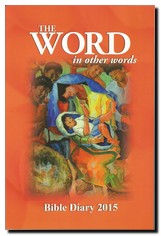THE WORD
Rom 8: 12–17 / Lk 13: 10–17
Jesus was teaching in a synagogue on the sabbath. And a woman was there who for eighteen years had been crippled by a spirit; she was bent over, completely incapable of standing erect. When Jesus saw her, he called to her and said, “Woman, you are set free of your infirmity.” He laid his hands on her, and she at once stood up straight and glorified God. But the leader of the synagogue, indignant that Jesus had cured on the sabbath, said to the crowd in reply, “There are six days when work should be done. Come on those days to be cured, not on the sabbath day.” The Lord said to him in reply, “Hypocrites! Does not each one of you on the sabbath untie his ox or his ass from the manger and lead it out for watering? This daughter of Abraham, whom Satan has bound for eighteen years now, ought she not to have been set free on the sabbath day from this bondage?” When he said this, all his adversaries were humiliated; and the whole crowd rejoiced at all the splendid deeds done by him.
IN OTHER WORDS
The scene in the Gospel is fraught with interesting particulars. Jesus was in the synagogue teaching on the Sabbath. This suggests that He was not only a devout Jew who observed God’s Law with diligence and faithfulness. He was also a highly admired Teacher who presumably taught in the place of worship on a regular basis. It may be supposed that like any good preacher, Jesus would always take time preparing His weekly discourse (homily), which sparkled with splendid insights and brilliant metaphors.
It is also remarkable that Jesus spotted the crippled woman among the crowd of worshippers. This shows that Jesus’ innate disposition is person-oriented. He does not deal with the crowd as an abstract, faceless whole; he regards people in their flesh and blood individuality.
Note that Jesus cured her by laying His hands on her. What a very reassuring and affirming gesture! What gentle and caring man Jesus was!
But why was the disabled woman present in the synagogue? Presumably, she was also a pious woman who, despite her physical handicap, regularly frequented the synagogue to worship God. Bodily infirmity, therefore, is not a hindrance to go to Church on Sundays and participate in the Eucharist. It was most likely on account of her religious piety that Jesus called to her and said, “Woman, you are set free of your infirmity.” She did not ask for deliverance from her infirmity. (It was Satan who bound her for eighteen years!) It was Jesus Himself who volunteered it.
Another character who catches our curiosity is the captain of the synagogue who became incensed that Jesus cured the woman on a Sabbath. Take note that he did not even look at Jesus in the face. He addressed his impertinent words to the assembly, while taking a cheap swipe at Jesus: “There are six days when work should be done. Come on those days to be cured, not on the Sabbath day.” What a wretched man!
So we have three interesting characters in today’s Gospel: Jesus, the Teacher and Healer; the crippled woman who persevered in worship despite her physical immobility and got cured; and the impudent synagogue leader. Let us imitate the first two and forget the third.
- Raymun J. Festin, SVD (CKMS, QC)
The Word in other words 2015
An annual project of Logos Publications, The WORD in Other Words Bible Diary contains daily scripture readings and reflections written by priest, brothers, and sisters of the three congregations founded by St. Arnold Janssen (the SVD, SSpS, and SSpSAP). It hopes to serve as a daily companion to readers who continually seek the correlation of the Word of God and human experience.


